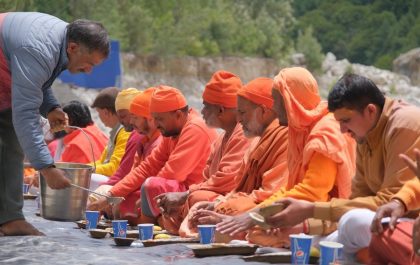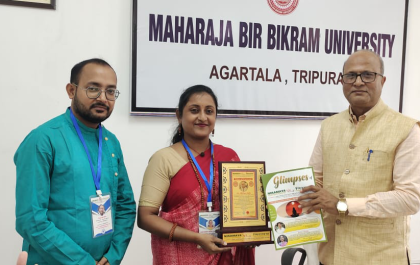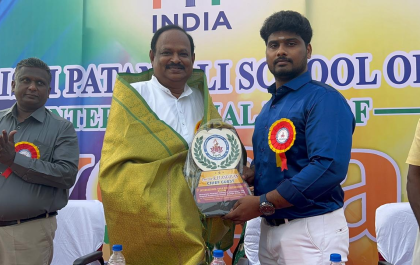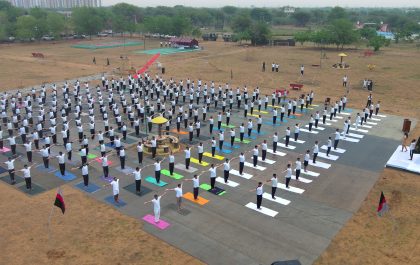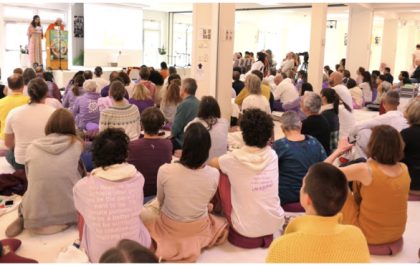by Shri M. Madhava Treasurer, Karnataka SCC (KrIYA)
Yoga is quite popular across the world. Millions practice Asanas daily and are obtaining benefits of this physical activity. While it is popular as a physical activity – almost as if it is an exercise – other elements of Ashtanga Yoga like Pranayama and Meditation are also popular.
However, there is limited appreciation of Yoga as a philosophical system. Yoga, is in fact, one of the six systems of Indian philosophy (Shad Darshana).
The accompanying chart provides an overview of the various philosophical systems within Sanatana Dharma. It is not exhaustive and only intends to provide a bird’s eye view. What the chart highlights is that the same set of scriptures forming part of Vaidika Dharma lend themselves to multiple interpretations and eventually different philosophical systems.
If there is any, this is indeed, “Unity in Diversity”!!
The Six Systems:
At the outset, we have two categories of systems. One that have the Vedas as their foundation and hence called Vaidika Dharma. The other category does not rely on the Vedas and hence are called Avaidika Dharma.
The popularly known “Six Systems” are part of the Vaidika Dharma. Buddhism, Jainism and Charvakas are Avaidika Dharma.
Let us now look at the body of scriptures which is the foundation of the Vaidika Dharma.
Vedic and Other Scriptures:
Vedas – Also known as Shruti
o Four Vedas – Rig Veda, Yajur Veda, Sama Veda, and Atharva Veda
o Each has four parts – Samhita, Brahmana, Aranyaka, and Upanishad
o Innumerable Upanishads but 10 Principal Upanishads as the three Acharyas have provided a commentary for them.
Vedangas – the tools to understand the Vedas
o Six of them – Shiksha, Vyakarana, Nirukta, Chandas, Jyotisha, and Kalpa
Dharma Shastras – Also known as Smriti. 18 major smritis.
o Manu Smriti, Yagnavalkya Smriti, Parashara Smriti etc.
Puranas – 18 of them
o Bhagavata, Vishnu Purana, Garuda Purana etc.
Itihasa – “So It has been” – History
o Ramayana
o Mahabharata
o Pancha Ratra (text not available but Acharyas have quoted from it)
On the basis of this body of scriptures, we have the following Six Darshanas or Philosophies.
Nyaya
Vaisheshika
Samkhya
Yoga
Purva Mimamsa (based on the earlier part of the Vedas / ritual-oriented)
Uttara Mimamsa (based on the latter part of the Vedas / knowledge-oriented) – widely known as Vedanta
o Dvaita, Advaita and Vishishtadvaita are all sub-categories of Vedanta. In fact, one can count about 16 variations within the Vedanta tradition
The above are twinned to form three broad sets:
Nyaya and Vaisheshika
Samkhya and Yoga
Purva Mimamsa and Uttara Mimamsa (Vedanta)
There are other variations as well. For instance, the Arya Samaj accepts only the Vedas and not the other scriptures (Puranas, Itihasa etc.). On the other hand, the Veerashaivas do not accept the Vedas but accept the Puranas.
Brief details of each of the Darshanas is provided in the chart above. As is clearly shown in the chart, each of the Darshanas borrows completely from the texts at the bottom. All the six Darshanas emanate from the entire corpus of Sanatana Dharma – Vedas, Smritis, Puranas and Itihasa Granthas.
All these philosophical systems accept the fundamental Vedic principles such as karma, rebirth, sin, virtue, heaven, hell, etc.
Therefore, Yoga is a Darshana – a philosophical system. A philosophical system equivalent to Vedanta. Yoga is not merely physical exercise. It is a Vedic path that can help humans reach the goal of life. References to Yoga can be found in the Vedas, Puranas, Ramayana, Mahabharata, and other texts.
While Yoga is a Vaidika Darshanas, non-Vedic religions like Buddhism and Jainism also give importance to Yoga. Similarly, Sikhism and even some Islamic Sufi sects accept Yoga in one form or another.
What does it mean when we say that Yoga is a Philosophy?
For a subject to be called philosophy, it should be answering some fundamental questions of life. Some of these questions would be:
What is the nature of reality?
How does the system define valid knowledge and what are the sources of knowledge?
Does the system acknowledge a God, or is it atheistic?
How does this system explain the origin, evolution, and dissolution of the universe?
What is the ultimate goal or purpose of human life (e.g., liberation, enlightenment, happiness)?
What is the path or means to achieve the ultimate goal?
What are the unique characteristics or contributions of this system that differentiate it from the other Darshanas?
While it would be difficult to address all these questions relating to all the six Darshanas, we take up these questions with relation to Yoga (and to a limited extend, Samkhya) to demonstrate the world view of Yoga.
What is the nature of reality – Ontology?
Yoga and Samkhya share their Ontology.
The world is real
While Samkhya accepts multiple entities, Yoga accepts two entities- Purusha and Prakriti
Prakriti manifests into 23 principles
How does the system define valid knowledge and what are the sources of knowledge?
Yoga and Samkhya share their Epistemology. The following are the valid sources of knowledge:
Direct or sensory Perception (pratyaksha)
Inference (anumana)
Verbal testimony (Agama). So, for instance, the Vedas are taken as Verbal testimony. Whatever is told in the Vedas is accepted in totality. There is no need for any proof.
It is interesting and important to note that Yoga also outlines the possibility of unlocking yogic perception through meditative practices, offering a path to direct knowledge beyond the limitations of ordinary perception and inference.
Does the system acknowledge a God, or is it atheistic?
While Samkhya is atheistic, Yoga advocates / believes in the existence of God – Ishwara.
How does this system explain the origin, evolution, and dissolution of the universe?
Both Yoga and Samkhya describe this as under:
The universe evolves from Prakriti due to the imbalance in its three Gunas – Sattva, Rajas and Tamas.
Purusha’s proximity to Prakriti triggers this evolution.
The 23 tattvas evolve in a specific sequence, leading to the manifestation of the cosmos.
The universe undergoes cyclical creation and dissolution.
What is the ultimate goal or purpose of human life (e.g., liberation, enlightenment, happiness)?
The objective of human existence is Kaivalya.
This translates to liberation, freedom, or absolute independence. It signifies the complete separation of Purusha (pure consciousness) from Prakriti (the material world) and the cessation of all suffering caused by the misidentification of the self with the ever-changing mind and body.
It is a state of pure, unconditioned consciousness, free from the cycles of birth and death.
In fact, the objective of Yoga philosophy is Viyoga!!
What is the path or means to achieve the ultimate goal?
While Samkhya prescribes Jnana – Knowledge, Yoga prescribes Ashtanga Yoga.
Let us delve in a little deeper:
The Imbalance of Gunas and the Beginning of the Process
In its primordial state, Prakriti is a state of equilibrium where the three Gunas (Sattva, Rajas, and Tamas) are balanced.
However, this equilibrium is disturbed, and this disturbance is the catalyst for creation and the beginning of the problems we experience.
This disturbance can be attributed to the influence of Purusha’s proximity (though Purusha itself doesn’t actively cause it).
When Sattva become dominant, Prakriti begins to evolve.
How the 23 principles Play the Game
Once Sattva becomes dominant, the 23 principles start to manifest in a specific sequence, and each plays a role in creating our experience of the world and our sense of bondage:
Mahat (Buddhi): When the Gunas are disturbed, Mahat, or the intellect, arises. It’s the first manifestation and the seat of awareness. It’s influenced by Sattva, so it provides the potential for understanding and discernment. However, it is also where the initial sense of “becoming” starts.
Ahamkara (Ego): From Mahat arises Ahamkara, the ego or the “I.” This is a crucial point where the sense of individuality and separation arises. It further obscures the true nature of Purusha. Ahamkara is influenced by Rajas, which drives the sense of “I act,” “I think,” leading to attachment and identification with the body-mind complex.
The Tanmatras (Subtle Elements): From Ahamkara arise the subtle elements (sound, touch, form, taste, smell). These are the potentials or objects for sensory experience. Tamas plays a role in making these potentials more concrete.
The Indriyas (Sense and Action Organs) and Manas (Mind): Ahamkara further gives rise to the sense organs (eyes, ears, etc.), the action organs (speech, hands, etc.), and the mind. These are the tools through which we perceive and interact with the world. Rajas drives the activity of the Indriyas and Manas, constantly pulling us outward.
The Mahabhutas (Gross Elements): Finally, the gross elements (earth, water, fire, air, ether) arise from the Tanmatras, solidifying the world we experience. Tamas is dominant in these elements, providing solidity and stability.
So, the interplay of the Gunas and the evolution of the 23 tattvas create a complex web of perception, action, and identification that obscures Purusha’s true nature and leads to suffering. We get caught up in the cycle of cause and effect, driven by desires, aversions, and ignorance.
A crucial realization from this framework is its fundamental departure from mainstream evolutionary thought. While conventional models, reinforced by materialist science, assert that consciousness arises from matter (mind evolves from matter), Yoga Darshana reverses this paradigm—establishing that matter itself emerges from consciousness (matter devolves from the mind). This perspective shifts the focus away from external cosmology and onto the inner dimensions of experience, highlighting that the first principle in cosmic evolution is Mahat or Buddhi, the seat of intelligence. Through its structured unfolding—from intellect to ego, subtle elements, sensory faculties, and ultimately the gross elements—this model illustrates how existence is shaped by awareness rather than physical processes. This shift challenges prevailing assumptions and invites a deeper exploration into the nature of reality through the primacy of consciousness.
How Yoga Helps Us Go Back in That Journey
Yoga provides a practical methodology, the eight limbs of Ashtanga Yoga, to reverse this entanglement of Purusha in Prakriti. This involves a multi-faceted approach:
Guna Regulation: Yoga practices help to cultivate Sattva (clarity, awareness) and reduce Rajas (activity, distraction) and Tamas (inertia, ignorance). This is achieved through ethical discipline, physical postures, breath control, and mental focus.
Controlling the principles:
o Indriyas and Manas: Pratyahara (sense withdrawal) and Dharana (concentration) help to detach the mind and senses from their objects, reducing the outward pull.
o Ahamkara: By reducing identification with the body-mind complex through the study of Moksha Sastras (Svadhyaya) and detachment (Vairagya), the grip of ego is loosened.
o Mahat: Through meditation (Dhyana) and Samadhi (absorption), higher states of awareness are cultivated, leading to the discrimination between Purusha and Prakriti.
o Ishvara Pranidhana: Surrender to Ishvara aids in reducing ego and facilitating the process.
By systematically working with the eight limbs, the practitioner gradually weakens the hold of Prakriti and its principles, allowing Purusha to realize it’s true, liberated nature (Kaivalya).
Yoga also comes out with a “How to” manual. The Siddhis that the Patanjali Yoga Sutras talk about are “testable”. In that sense, it adds a layer to the Pramanas or sources of knowledge. It provides for “revelation” of knowledge at “different stages of evolution of consciousness”
